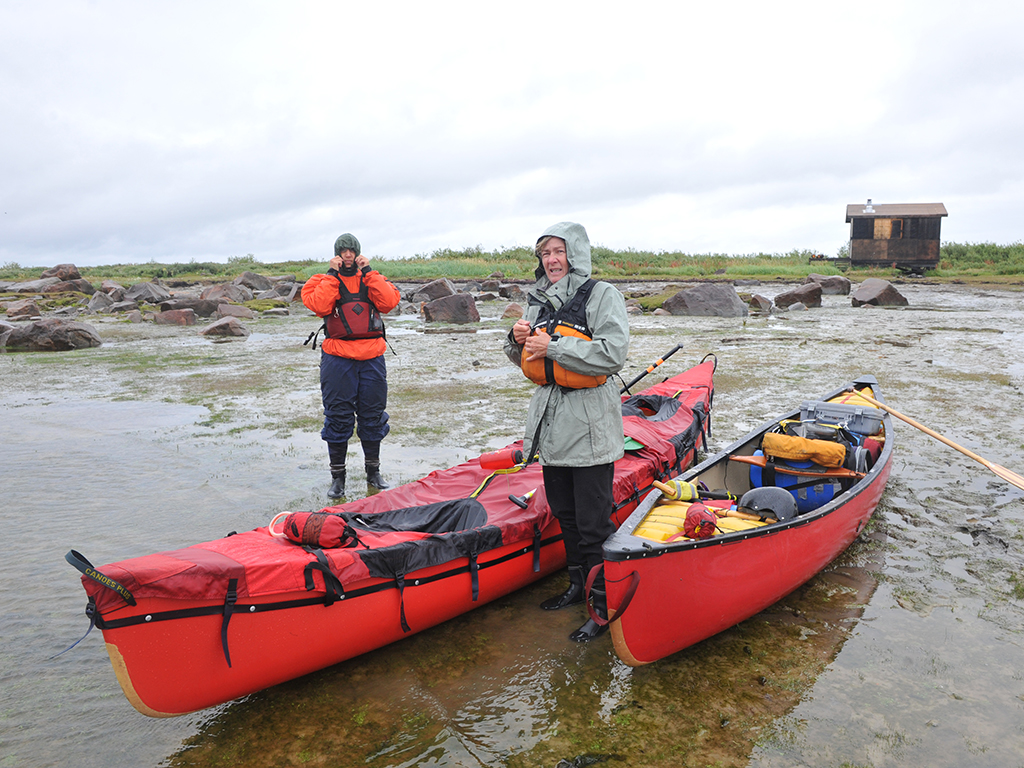What you bring along to wear on the water and on land is one of the most important parts of river trips because you never know what the weather will bring. Without proper clothing, a trip can turn potentially disastrous – hypothermia and heat stroke can easily set in if you haven’t packed the right attire.
My Personal Equipment Checklist
Lifejacket
– front zip type – easy to unzip for cooling down and more comfortable when paddling flatwater
– with pocket – for a small emergency zip-lock bag that holds an emergency blanket, small knife, and lighter
Paddling helmet
– helmets designed for water (as opposed to a biking helmet or similar) will hold less water in the helmet padding
Water shoes
– water shoes with flexible soles – gives support on land but allows for more comfortable positioning in the boat
or
– neoprene booties – above ankle style keeps your feet warmer and protects the ankles and feet from biting insects and sharp objects on the portage trail
Paddling clothes:
(Warmer weather)
Zip-off pants – polyester quick dry
– for cold and sun protection and easy to convert to shorts when the weather gets warm
Long sleeve quick dry polyester shirt
– it helps protects against the sun and some biting insects
Windbreaker jacket
– nylon or polyester (quick drying) – a welcome addition in the wind and rain
Long sleeve fleece or merino wool sweater
– a must when the weather cools down or turns nasty (it works great with the windbreaker over top)
Sun hat
– I use a baseball cap but something that protects the neck might be a smarter option Sunglasses
– I store an old pair (usually found on some rocky riverbank) in my lifejacket for easy access
Paddling socks
– (optional) (light polyester or wool) – not sure why other than it feels good on my feet (my wife doesn’t understand it either)
(Colder weather)
Wet suit
– farmer’s style for cold water paddling (dry suits are a must for very cold water but can sometimes cause overheating in warmer weather which leads to being wet on the inside)
– make sure the wetsuits zipper opens low enough to make it is relatively easy to relieve yourself
– for more warmth, wear a windbreaker over top
Dry Land Clothing:
Wool blend socks
Underwear
Fleece pants or merino wool pants
Wind or Gortex pants
Polyester turtleneck or long sleeved shirt
Fleece or merino wool jacket or sweater
Rain jacket or windbreaker
Rain suit (rubber and fully waterproof)
– for emergencies (no points for style but a rain suit has saved my skin in boisterous weather on more than one occasion)
Winter hat
– a thin wool ski toque is great, especially when you need to keep your head warm at night
Hiking boots
– Gortex ones are the bomb and are worth the cost becasue keeping your feet dry is crucial to survival in the wilderness for long periods of time
T‑shirt
– cotton for comfort –around the campfire or in bed, it’s my one clothing faux pas
Accessories
Camera gear – either an SLR camera stored in a Pelican waterproof case and/or a waterproof compact camera stored in your lifejacket – don’t take the chance of using your phone camera
Headlight – make sure it is comfortable, easy to use, and bright enough to spot nearby wildlife at night
Journal and pencil – pencils work in almost any weather
Reading material – be realistic – hard cover books are heavy and take up a lot of room
Multi‑purpose knife (Swiss Army or similar)
Lighter and extra matches
Fishing rod or line and lures
Personal hygiene bag (toothpaste, toothbrush, floss, etc.)
Small towel (tea towel works well and dries fast)
Personal medication
Spirit of adventure
General Clothing Tips
- Do not wear cotton – it never dries on the river and does nothing against the cold
- Wear light coloured clothing – a friend who happens to be a world-renowned expert on blackflies and mosquitoes confirms that these annoying insects are attracted less to light colours and much more attracted to blacks and blues. While we’re n the subject, don’t use fragrances – they also attract bugs
- Prepare to get wet – no matter how hard you try, I can almost guarantee that you will get wet, especially going to and from the boat to shore. Don’t make the mistake of wearing your dry land footwear in the boat.
- Dress in layers. It’s the best way to keep warm.
- Roll your clothes military style to save space. Put some of your clothes in a stuff sac which you can convert to a pillow come bed time.
- 6. Split your clothes up into two different barrels or duffel bags in case one leaks.
